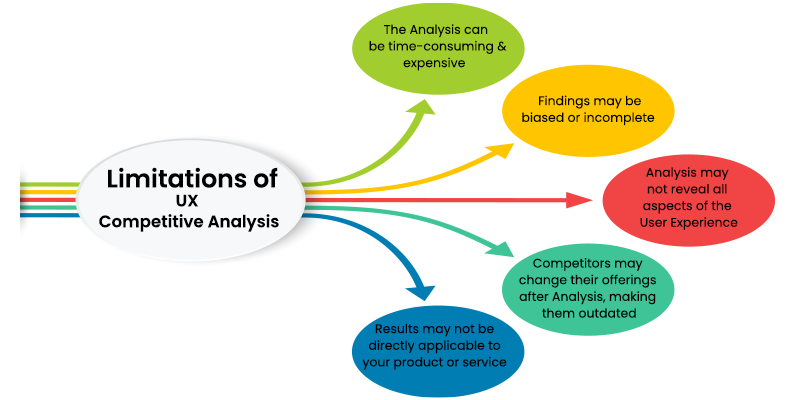
Mastering Competitive Analysis in UX to Create Exceptional User Experience
Competitive Analysis in UX (User Experience) is researching and analyzing your competitors to understand their strengths, weaknesses, and overall strategies for your own UX Design. It involves gathering and evaluating information about your competitors’ products or services, their User Experience, and their marketing and branding efforts. The purpose of conducting a Competitive Analysis in UX is to gain insight into what works and what doesn’t work in your industry, and identify opportunities for improvement in your User Experience. By understanding the strengths and weaknesses of your competitors, you can make informed decisions about your own UX Design, improve your user engagement, increase your conversion rates, and ultimately gain a competitive advantage.

Outsmarting the Competition: Why Competitive Analysis is Essential in UX Design
Competitive Analysis can be performed at various stages of a UX Design Project, depending on the specific needs and goals of the Project. Here are some common scenarios when a Competitive Analysis may be performed:
Project Initiation Phase:
Competitive Analysis is performed at the Project’s outset, to understand the competitive landscape and identify potential opportunities and threats.

Research Phase:
Competitive Analysis is conducted as part of the Research Phase to understand the current User Experience and identify areas for improvement.
Project Initiation Phase:
Competitive Analysis is performed during the Redesigning and Product Improvement Phase. It helps to identify the areas where your competitors have an advantage, and find ways to differentiate the product.
Final Launch Phase:
When launching a new product, businesses can perform Competitor Analysis to understand and position themselves in the market and identify opportunities to differentiate their products. Overall, Competitive Analysis should be an ongoing process throughout the UX Design Project. Companies must update, revise, and stay ahead as the competitive landscape changes and new products are introduced.
How to Conduct a Competitive UX Analysis?

When conducting a UX Competitive Analysis, it’s essential to consider both the visual and technical aspects of your competitors’ websites or apps. Here’s a method that gives more importance to technical terms:
Identify Your Competitors:
Your Competitors whose websites or apps you want to analyze. These could be companies offering similar products or services to yours or targeting the same audience.
Use Technical Tools:
Use Technical Tools like Google Analytics, SimilarWeb, or SEMRush to gather data on your competitors’ websites. This data will give you insights into their traffic sources, keywords, page load times, and other technical aspects.
Analyze Website Structure:
Analyze your competitors’ Website Structure, including their URLs, sitemap, navigation, and internal linking. This Analysis will help you understand how they organize their content and the hierarchy of their website.
Evaluate Technical Performance:
Evaluate the Technical Performance of your competitors’ websites, including page speed, mobile responsiveness, accessibility, and security. Use tools like PageSpeed Insights, Lighthouse, or GTmetrix to Evaluate Technical Performance.
Identify Technical Features:
Identify Technical Features such as search functionality, filters, forms, payment gateways, or integrations that your competitors’ websites have. This Analysis will help you understand how your competitors use technology to enhance the User Experience.
Conduct A Heuristic Evaluation:
Conduct a Heuristic Evaluation of your competitors’ websites, a usability evaluation technique that involves reviewing a website based on predefined criteria. This evaluation will help you identify usability issues and opportunities for improvement.
Analyze User Feedback:
Analyze User Feedback such as reviews, comments, or surveys on your competitors’ websites.
What Is The Purpose Of A UX Competitive Analysis?
A UX (User Experience) Competitive Analysis aims to better understand your competitors’ User Experience, marketing strategies, and overall positioning in the market. You can identify opportunities to improve your User Experience and gain a Competitive Advantage by analyzing and evaluating your competitors’ strengths and weaknesses.
Why Should You Do A UX Competitive Analysis?
There are several reasons why you should conduct a UX (User Experience) Competitive Analysis:

Benefits of UX Competitive Analysis:
Identify Areas for Improvement:
Conducting a Competitive Analysis can help you identify areas where your competitors excel and areas where they fall short. By analyzing their products or services, you can identify opportunities to differentiate your product or service and create a better User Experience. For example, you might discover that your competitor’s checkout process is overly complicated, which could inspire you to create a simpler and more streamlined checkout process for your product.
Gain Insights Into User Behavior:

A competitive UX Analysis can help you understand how users interact with similar products or services, what they like and dislike, and what they expect from a User Experience. This information can be used to create a user-centered design that meets the needs and preferences of your target audience. By understanding your users’ behavior and preferences, you can create a design that is intuitive, easy to use, and meets their needs.
Avoid Making the Same Mistakes As Your Competitors:
By learning from your competitors’ mistakes, you can avoid making the same ones and create a better product or service. For example, if you notice that your competitor’s website has a slow loading time, you can prioritize optimizing the speed of your website to avoid frustrating users
Make Informed Decisions Based On Research And Data:
A competitive UX Analysis provides valuable research and data that can be used to inform your design decisions. By analyzing your competitors’ products or services, you can make informed decisions about the features and functionality you should include in your product or service.

Limitations of UX Competitive Design:
While conducting a Competitive Analysis in UX Design can be a valuable tool to gain insights and improve the User Experience of a product or service, it is important to be aware of its limitations. Some limitations of UX Competitive Analysis include the following:
Time-Consuming And Expensive:
Conducting a Competitive Analysis requires significant time and resources to gather and analyze data. Depending on the scope of the Analysis, it can be costly and time-consuming.
Biased or Incomplete Results:
Competitive Analysis relies on the accuracy and completeness of the data collected. If the Analysis is not conducted using a comprehensive methodology, or if the data collected is biased or incomplete, the results may not be accurate or representative of the entire User Experience
Outdated Results:
The competitive landscape constantly changes, and competitors may modify their products or services after the Analysis. It means that the Analysis results may not reflect the current state of the market.
Limited Scope:
A Competitive Analysis may not provide a complete picture of the User Experience. It may focus on a specific aspect of the User Experience or a limited set of competitors, which may not provide a comprehensive view of the competitive landscape.
Applicability Of Results:
The results of a Competitive Analysis may not be directly applicable to the product or service designed. Each product or service is unique, and what works for one may not work for another. Therefore, it is important to use the results of the Competitive Analysis in conjunction with other research methods and user testing to make informed design decisions. While Competitive Analysis in UX Design can provide valuable insights, it is important to be aware of its limitations, and to use it as one tool in a comprehensive UX Design Process.

Key Take Aways:
Conducting a Competitive Analysis in UX Design is like playing detective: you need to investigate what your competitors are doing to create better products and experiences. The first step in a Competitive Analysis is identifying your competitors and researching their products or services to see how they compare to yours. Once you’ve gathered information about your competitors, it’s time to Analyze it and identify patterns or trends that could inform your UX Design. When analyzing your competitors, pay attention to their strengths, weaknesses, and areas for improvement. It helps you to identify opportunities to differentiate your product or service. Use the findings from your Competitive Analysis to inform your own UX Design and create a better product or service for your users. Remember to focus on the user’s needs and preferences throughout the Design Process
FAQs:
1. Who Should Conduct a UX Competitor Analysis?
Anyone involved in designing, developing, or managing a product or service can conduct a UX Competitor Analysis. It is especially important for UX designers, product managers, and marketers.
2. How Often Should a UX Competitor Analysis Be Conducted?
It is recommended to conduct a Competitive Analysis on a regular basis, such as quarterly or bi-annually, to stay up to date with industry trends and changes in the competitive landscape.
3. What Are Some Tools for Conducting a UX Competitor Analysis?
Various tools including website analytics tools, user testing platforms, and market research reports are available for conducting a Competitive Analysis.
4. What Are Some Common Pitfalls to Avoid When Conducting a UX Competitor Analysis?
Common Pitfalls include:
- Focusing too much on features rather than User Experience.
- Failing to consider user needs and preferences.
- Relying too heavily on quantitative data.
5. How Do You Use Insights from a UX Competitor Analysis to Improve Your User Experience?
You can use insights from Competitive Analysis to identify areas for improvement in your own User Experience, differentiate your product or service, and create a more user-friendly and engaging experience for your users.
Popular Searches:
Get Free Quote
Facebook
Twitter
LinkedIn
WhatsApp

 India
India USA
USA


